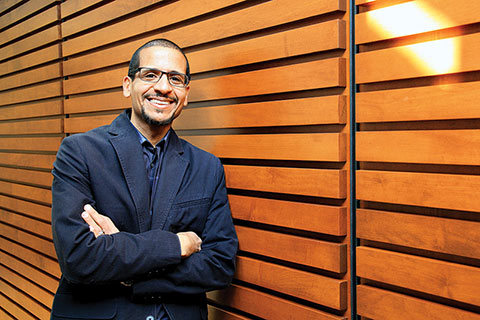Sociology professor Randol Contreras is back in the classroom this fall after spending much of the summer with Mexican American gang members on the streets of Los Angeles. What sounds like a very atypical vacation choice was, in fact, integral to his ongoing research into what drives people to crime in marginalized urban communities. “Academics often treat these individuals as objects and analyze them from a distance,” says Contreras, who joined U of T Mississauga in 2014.
Contreras had his own unsuccessful stint as a crack dealer before a concerned friend signed him up for community college, so he empathizes with many of his interview subjects. “I try to get to the everyday struggles and anguish that individuals feel by developing relationships with them,” he says.
Contreras became interested in the Maravilla gangs in 2013 while working at California State University, Fullerton. (Maravilla is the original name for East L.A., and there are Maravilla gangs in almost 20 neighbourhoods in the area.) His research aims to explain how large social and economic forces lead to despair in underprivileged neighbourhoods, generating a downward spiral of violence, drugs and criminality. With the Maravilla gangs, he is examining how the economic recession of 2008–2009 and the uneven recovery in the U.S. have affected aging gang members, who, as ex-convicts with histories of addiction, face extremely limited job prospects.
He is also interested in the consequences of an incident in the early 1990s when the Maravilla gangs defied California’s dominant gang, the Mexican Mafia. This led to them being “green-lighted” by the Mexican Mafia: Mafia members were ordered to attack or kill them on sight, increasing the violence and victimization experienced by Maravilla members. (The green-light is in force today on several Maravilla gangs that continue their resistance.)
Contreras, who returns to L.A. on winter and summer breaks, always tells the gang members he is a researcher, but he slowly earned their trust by dressing like them, volunteering to teach handball – one of their favourite sports – at a local community centre, and simply hanging out on the street listening to their tales of violence, gang honour and economic hardship.
His aim is to publish a book that offers new insight into why offenders do what they do, and the consequences. “The research is risky, especially because it involves the Mexican Mafia,” says Contreras. “People have told me that once I publish it I can never go back to L.A.”
This is not the first time Contreras has documented the criminal underworld from the inside. His book The Stickup Kids, based in South Bronx where he grew up, details how the fall of the crack economy led his friends to switch from drug dealing to robbing drug dealers. “As sociologists, we’re doing science, but this is not a laboratory where we study behaviours without understanding how people feel,” he adds. “If someone is angry, I want to show the anger. If they’re in pain, I want to show the pain.”
Recent Posts
For Greener Buildings, We Need to Rethink How We Construct Them
To meet its pledge to be carbon neutral by 2050, Canada needs to cut emissions from the construction industry. Architecture prof Kelly Doran has ideas
U of T’s 197th Birthday Quiz
Test your knowledge of all things U of T in honour of the university’s 197th anniversary on March 15!
Are Cold Plunges Good for You?
Research suggests they are, in three ways






One Response to “ The Inner Lives of Gang Members ”
Prof. Contreras was one of the last professors I had before I graduated. I was in one of the first classes he taught at UTM (SOC415 Senior Seminar - Drugs in the City, if my memory serves me correctly). He was a great professor, and the course was very compelling. By the end of the semester, the knowledge I gained made me look more analytically at crime and sociological forces that can sustain, produce or circumvent criminal actions. Thanks Prof. Contreras, for teaching my favourite course ever!